REVYTA - New life for boat-industry composites
Gluing composite materials is a real challenge. But structural adhesives can be used to glue different materials: they don’t cause problems either for composites, which do not react well to soldering or drilling, or for aluminium or other light metals that can easily be deformed by heat. In addition, structural adhesives allow great freedom for designers and enable the use of automated processes.
Glass fibre reinforced plastic – challenge to meet the recycling requirements
Glass fibre reinforced plastic (GFRP) composite materials are of great interest in technologically advanced sectors like the boat-building and naval industry. GFRP consists of glass fibres (cut or woven) incorporated in a matrix of thermosetting resins, usually vinyl ester or polyester-based. Thanks to their lightness, and mechanical and corrosion resistance, GFRP composites are extensively used in a number of industrial sectors. However, they do have some disadvantages in relation to their environmental impact as they still do not meet the criteria of reduction, re-use and recycling (the 3Rs). In addition, most of the polymers and stiffeners used to produce GFRP composites come from non-renewable sources or require a very large amount of energy for production.
For years, people have been trying to solve the problem of recycling GFRP in particular/particularly and composites in general. While a considerable effort has been made at the international level to find economically sustainable solutions, as things stand there are several recycling techniques but none of them are really satisfactory.

A great deal remains to be done
In the nautical and naval sector, for cost reasons, dismantling operations at the end of the vessel’s life in low or very low-cost countries, are conducted in a questionable and unregulated manner, in low or very low-cost countries.
A great deal remains to be done and to be validated in terms of treatment facilities for the recovery/recycling of fibreglass to obtain technologically feasible and economically profitable processes at the industrial level.
In addition, the implementation of any recovery/recycling process necessarily involves the prior demolition, dismantling and disassembly of end-of-life products containing fibreglass.
These stages are no less delicate and have no less of an economic impact, in terms of the feasibility of the entire circular process, than the treatment stages for the recovery/recycling of fibreglass.
GFRP composites are mainly used for large, complex products. We need only think of their use in the nautical sector for boat and yacht production. So the cost-effectiveness of recycling also involves a re-thinking of the design process with a view to designing new products that take into account their end-of-life disassembly.
Another factor is the reorganisation of demolition operations to use robotisation to reduce the intervention of unskilled personnel in manufacturing processes such as hull cutting that are[RNT3] demanding in terms of human resources and risky in terms of workers’ health and safety.
Revyta Project – new possible solutions?
In Italy, Tuscany region – an industrial district where some of the world’s biggest and most important boatyards are concentrated – is very aware of the problem of how to recycle vessels at end-of-life. And it is in Tuscany that Revyta, a major research project devoted to recycling composites in the nautical sphere, has just been launched.
The aim of this project is to propose a sustainable industrial model for fibreglass recycling, a model that does not yet exist in Europe. The project focuses on dismantling, disposing of and recycling the fibreglass used in boat-building and also in the automotive and other transport sectors, for example campervans and train carriages. With an investment cost of 1.5 million euro (50% co-financed by Tuscany Region), Revyta’s goal is to develop, in about two years, an integrated platform to manage the entire recycling process. The project will use existing technologies to best effect, from robotics for disassembly and material selection to treatment with a patented chemical substance currently being tested to obtain high-added-value fibres and resins.

Pietro Angelini Revyta - Head of the project
Developing the answer
The project will need to identify and test any and all automation and robotics solutions encompassed by the Industry 4.0 Strategy that can be used to speed up the cutting of the fibreglass components. The aim here is to avoid operations that pose dangers to workers’ health while also upgrading their skills, and to dramatically cut costs and improve profit margins, thanks not least to increased flexibility in production (for example in the product mix and quantities). The use of robotics will make it possible to develop flexible and adaptable solutions for the dismantling of yacht and train carriage components by reprogramming the platform’s software. This will produce technical solutions that can be used extensively across all three segments involved.
The companies involved in developing the technology for the roboticised platform will be led by the Scuola Superiore di Sant’Anna, which is recognised as an international centre of excellence in research on these technologies. Partners in the project are confident their work will result in a practicable and profitable solution to achieve this ambitious goal.
Another key problem is to develop the recovery process. Obtaining fibreglass recycling products must necessarily entail a number of economically sustainable transformation processes. The solutions currently available on the market and in technological research range from simple mechanical crushing processes to more complex heat and chemical processes. The range of products that can be obtained is considerable and even includes virgin raw materials such as glass fibres and resins. To achieve this, the project will have to ascertain the costs and real market value for each product.
In the course of the project, it will thus be possible to test and verify the performance of an innovative patented industrial process that seems to enable the recovery of high yields of resin and glass fibres. The mechanical properties of the materials obtained will also need to be verified in order to assess their new types of use. Laboratory tests and finite element software will provide advanced technological support in validating the materials.
The manufacturing companies directly involved in the project will then need to re-examine their products, including from a design perspective, with a view to simplifying their end-of-life dismantling processes and the recovery of the materials used. The aim is to understand how to transfer design principles and end-of-life good practices already developed in other sectors, such as car-making, to the nautical sector.
Share your stories on leisure marine industry with us
Do you have an innovation, research results or an other interesting topic you would like to share with the leisure marine equipment industry? The METSTRADE website and social media channels are a great platform to showcase your stories! Let us know via metstrade@rai.nl
Are you a METSTRADE exhibitor?
Make sure you add your latest press releases to your Company Profile in the Exhibitor Portal for free exposure.





